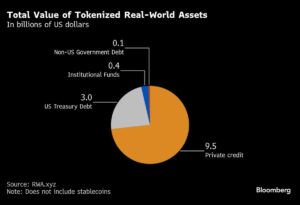The Rise of Tokenization: Revolutionizing Asset Ownership in a Digital World
The recent surge in Bitcoin’s value has reignited enthusiasm for the blockchain technology that underlies cryptocurrencies. Beyond its potential for currency transactions, the concept of tokenization—creating digital representations of physical assets on a blockchain—is emerging as a game changer for industries ranging from real estate to financial securities.
Despite its promise, tokenization has historically struggled to establish a foothold. Data from rwa.xyz reveals that only about 67,530 entities, predominantly institutional investors, currently hold non-stablecoin tokenized assets. Alarmingly, tokenization accounts for merely 0.003% of the global asset value, and many companies invested in tokenization initiatives are teetering on the edge of insolvency, as indicated by research from Opimas.
A significant hurdle for tokenization has been the regulatory environment. In the U.S., the framework surrounding cryptocurrency and related technologies was conservative, often discouraging banks from engaging with crypto assets. Tokenized securities, while operating under the same rules as traditional securities, were frequently scrutinized alongside cryptocurrencies. In response, many financial institutions opted to divert their investment towards sectors like artificial intelligence, leading to stagnation in tokenized asset markets.
However, a tide of change is on the horizon. With the potential for a more favorable regulatory environment under the leadership of President-elect Donald Trump, momentum is beginning to pick up. Notably, BlackRock Inc., the world’s largest asset manager, has already taken the plunge by launching a tokenized money-market fund, prompting others to reconsider their strategies.
As more players enter the tokenization space, established financial entities are now actively engaging in this digital shift. Just this year, Visa launched a platform enabling banks to issue fiat-backed tokens, while Mastercard connected its token network with JPMorgan Chase to facilitate cross-border transactions. Raj Dhamodharan, Mastercard’s EVP for blockchain and digital assets, stated, “This trend will continue to evolve and unlock numerous new business models.” With Kinexys, JPMorgan supports transactions nearing $2 billion daily, showcasing the immense potential of blockchain-powered financial systems.
A forecast from the Boston Consulting Group suggests that the total managed assets for tokenized funds could soar to $600 billion by 2030, significantly up from the current figure of around $2 billion. Efforts are also underway by the Commodity Futures Trading Commission (CFTC) to develop guidelines for the use of tokenized assets as collateral, potentially enhancing their utility.
Tokenization is positioned not just as a matter of convenience; it could pave the way for improving liquidity, making assets more accessible to a broader range of investors. As Rob Krugman, Chief Digital Officer at Broadridge, noted, “By tokenizing those assets, it enables natural efficiency.” Some industry leaders even suggest that this shift may eclipse the internet in transforming the market landscape.
However, with excitement comes caution. Concerns grow that the rush to tokenize could lead to the inclusion of inferior assets that shouldn’t be digitalized. Experts like Nathan Allman, CEO of Ondo Finance, warn that this could leave uninformed investors exposed to high fees and low-quality products. Furthermore, the allure of owning a piece of a tokenized masterpiece, such as a Picasso, raises philosophical questions about the enjoyment of art detached from its physical presence.
On the positive side, the programmability of blockchain assets brings the opportunity to mitigate risks—such as counterparty exposure—through automation and escrow mechanisms. Enhanced efficiency in the payments workflow via blockchain was also recognized by Capco analysts, who emphasize the potential benefits of integrating this technology into existing financial systems, even as they acknowledge that execution will take time.
In navigating the complexities of this burgeoning space, it’s essential for investors and innovators alike to prioritize both opportunity and prudence. Tokenization stands at the forefront of modern finance, and its evolution will be closely watched as we explore the limitless possibilities of the digital economy. As we move forward, Extreme Investor Network will keep you informed on how these trends develop and how you can benefit as they unfold.

